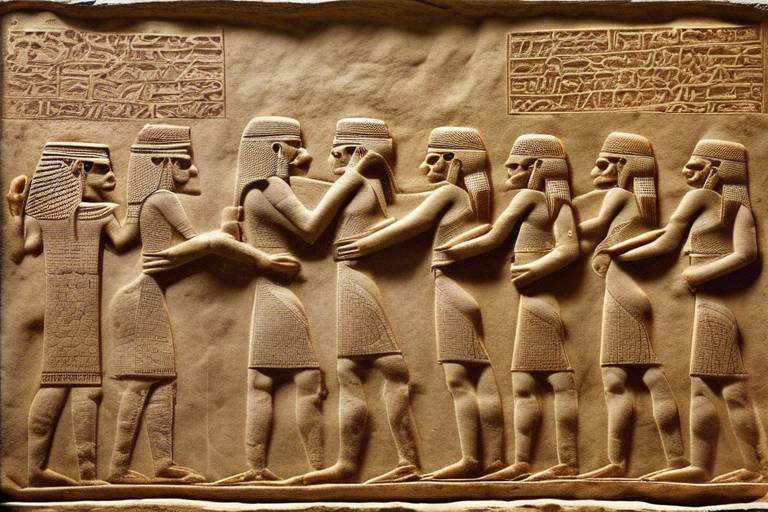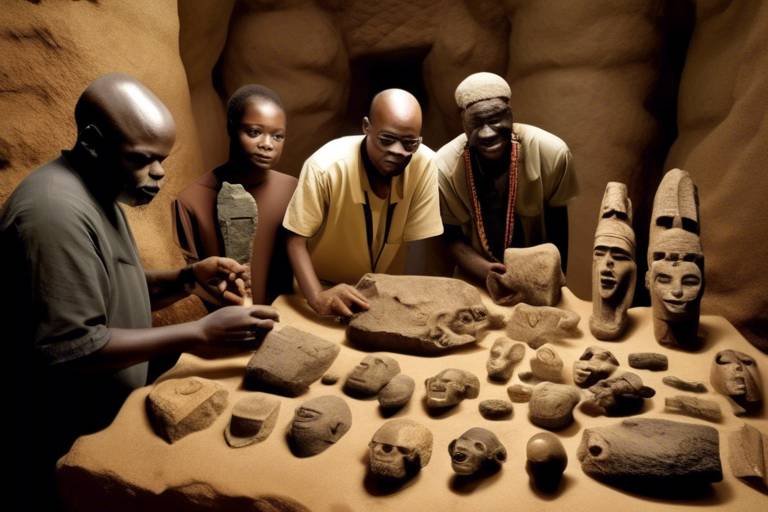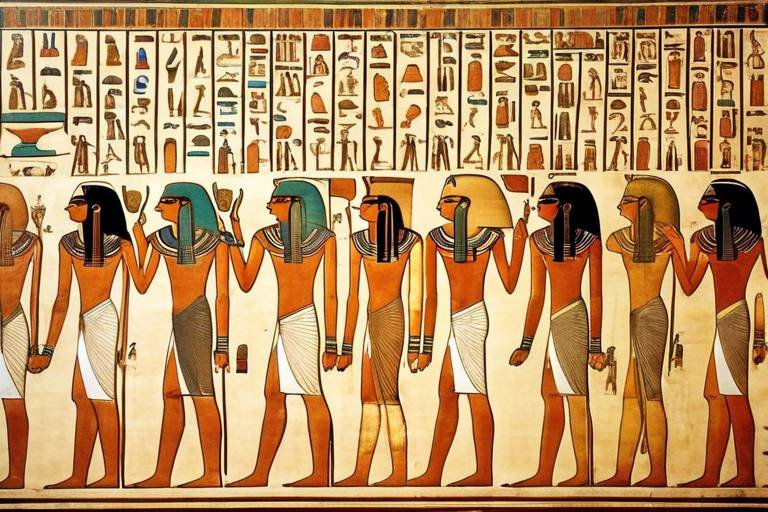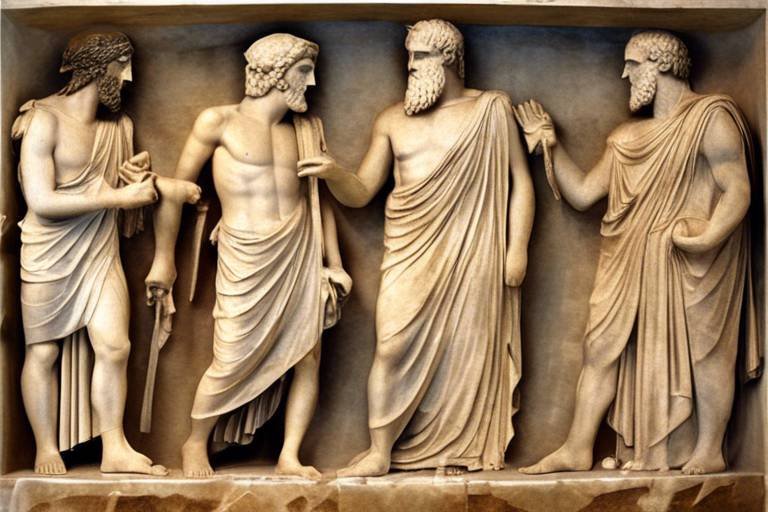The Discovery of the Ancient Mesopotamian Art
Have you ever wondered about the captivating world of Ancient Mesopotamian art? The discovery of this ancient art form has unveiled a treasure trove of artistic expression that continues to fascinate and inspire us today. From intricate clay tablets to towering ziggurats, Mesopotamian art offers a window into the rich history and cultural legacy of this ancient civilization.
As archaeologists unearth ancient artifacts and unearth the remnants of Mesopotamian cities, we are able to piece together the story of a society that valued art and craftsmanship. The intricate carvings, vibrant murals, and imposing monuments stand as a testament to the creativity and ingenuity of the Mesopotamian people.
Exploring the origins of Mesopotamian art takes us on a journey through time, tracing back to the Sumerians and Akkadians who laid the foundation for artistic expression in this region. The early forms of art, characterized by intricate patterns and symbolic motifs, reflect the cultural and religious beliefs of these ancient civilizations.
One cannot overlook the techniques and materials used by Mesopotamian artists, from the malleable clay to the enduring stone and precious metals. These choices not only shaped the aesthetics of their art but also contributed to the longevity and durability of their creations, allowing us to marvel at their craftsmanship thousands of years later.
The symbolism and iconography present in Mesopotamian art offer a glimpse into the beliefs and values of this ancient society. Common motifs such as the rosette, the lion, and the tree of life carry deep symbolic meanings, serving as a visual language to convey religious, political, and social messages to the viewer.
Architecture played a significant role in Mesopotamian society, with grand structures like ziggurats, temples, and palaces serving as symbols of power and prestige. These monumental buildings not only showcased the architectural prowess of the Mesopotamians but also served practical purposes in religious ceremonies and administrative functions.
The legacy of Mesopotamian art extends far beyond the boundaries of this ancient civilization, influencing subsequent cultures and civilizations such as the Assyrians, Babylonians, and Persians. The artistic motifs and techniques developed by the Mesopotamians continue to echo in art forms around the world, leaving a lasting imprint on the artistic heritage of humanity.
Despite the challenges faced in preserving Mesopotamian artifacts, including issues of looting and illegal trade, ongoing research initiatives and technological advancements offer hope for the future of Mesopotamian art studies. With each new discovery, we gain a deeper understanding of this ancient civilization's artistic achievements and cultural significance.
As we delve into the world of Mesopotamian art, we are reminded of the enduring power of creativity and artistic expression to transcend time and connect us to the past. The discovery of this ancient art continues to captivate and inspire us, offering a glimpse into a world rich in history, symbolism, and artistic mastery.

The Origins of Mesopotamian Art
The origins of Mesopotamian art can be traced back to the ancient civilizations of Sumer and Akkad, dating back to around the 4th millennium BCE. These early societies laid the foundation for artistic expression in the region, with a focus on depicting scenes from daily life, religious beliefs, and mythological narratives. The Sumerians, known for their advanced city-states and writing system, developed intricate forms of art, including cylinder seals used for administrative and artistic purposes.
Artifacts from this period reveal the use of clay, stone, and metal as primary materials for creating sculptures, pottery, and jewelry. The art of Mesopotamia was characterized by its intricate designs, symbolic motifs, and narrative storytelling. Artists often depicted gods, kings, and mythical creatures in their works, showcasing a blend of realism and symbolic representation.
The art of Mesopotamia was not only aesthetically pleasing but also served practical purposes, such as honoring deities, commemorating historical events, and asserting political power. The artistry of this ancient civilization reflected a complex society with a strong emphasis on religion, hierarchy, and the afterlife.
**Frequently Asked Questions:** 1. **What were the main themes in Mesopotamian art?** - Mesopotamian art often depicted religious scenes, mythological narratives, royal figures, and daily life activities. Symbolism played a significant role in conveying messages related to power, divinity, and social hierarchy. 2. **How did Mesopotamian artists use symbolism in their art?** - Artists in Mesopotamia employed symbols such as the rosette, the lion, and the tree of life to convey specific meanings related to fertility, protection, and the cycle of life. These symbols were rich in cultural significance and were used across various art forms. 3. **What materials were commonly used in Mesopotamian art?** - Clay was a prevalent material in Mesopotamian art due to its abundance and versatility. Additionally, artists utilized stone, metal, and precious gems to create intricate sculptures, jewelry, and architectural embellishments. 4. **How did Mesopotamian art influence later civilizations?** - The artistic techniques and motifs developed in Mesopotamia influenced neighboring civilizations such as the Assyrians, Babylonians, and Persians. The legacy of Mesopotamian art can be seen in the architectural styles, decorative motifs, and religious symbolism of these cultures. 5. **What challenges are faced in preserving Mesopotamian artifacts today?** - Preserving Mesopotamian artifacts is a complex task due to issues such as looting, illegal trade, environmental degradation, and the impact of modern development on archaeological sites. Efforts are being made to safeguard these valuable cultural heritage objects for future generations.
Techniques and Materials Used in Mesopotamian Art
Exploring the rich history and significance of Mesopotamian art, showcasing its influence on modern art and culture, and examining the archaeological findings that shed light on this ancient civilization's artistic achievements.
Tracing the roots of Mesopotamian art back to the Sumerians and Akkadians, exploring the early forms of artistic expression in this region, and highlighting the key motifs and themes prevalent in their art.
When delving into the world of Mesopotamian art, one cannot help but marvel at the innovative techniques and materials employed by the ancient artists. Clay, stone, and metal were the primary mediums used in creating their masterpieces. The choice of materials not only influenced the style of the artworks but also contributed to their durability and longevity. For instance, the use of clay allowed for intricate details to be sculpted, while stone provided a sturdy foundation for monumental sculptures and reliefs. Metalwork showcased the craftsmanship and skill of Mesopotamian artisans, with intricate designs adorning jewelry and ceremonial objects.
Moreover, the techniques used in Mesopotamian art were highly advanced for their time. Artists employed methods such as relief carving, inlaying, and glazing to enhance the visual appeal of their creations. These techniques added depth and complexity to the artworks, making them stand out as remarkable examples of ancient craftsmanship.
Analyzing the symbolic meanings behind common motifs like the rosette, the lion, and the tree of life in Mesopotamian art, and exploring how these symbols were used to convey religious, political, and social messages.
Exploring the grand architectural achievements of Mesopotamia, including ziggurats, temples, and palaces, and examining how these monumental structures reflected the power and beliefs of the ancient Mesopotamian societies.
Investigating the multifaceted role of art in Mesopotamian society, from its function in religious rituals and royal propaganda to its use in recording historical events and daily life, and its impact on social structures.
Examining the lasting impact of Mesopotamian art on subsequent civilizations, including the Assyrians, Babylonians, and Persians, and tracing the influence of Mesopotamian artistic motifs and techniques in art forms around the world.
Discussing the difficulties faced in preserving and protecting Mesopotamian artifacts, including issues related to looting, illegal trade, and the impact of modern development on archaeological sites in the region.
Highlighting ongoing research initiatives and technological advancements in the field of Mesopotamian art studies, and discussing the potential for new discoveries and insights into this ancient civilization's artistic heritage.
Stay tuned for the answers to common questions about Mesopotamian art, including insights into the symbolism, techniques, and legacy of this ancient artistic tradition.

Symbolism and Iconography in Mesopotamian Art
When delving into the world of Mesopotamian art, one cannot ignore the profound symbolism and intricate iconography that define this ancient civilization's artistic expression. Mesopotamian art is a treasure trove of symbols and motifs that carry deep meanings, reflecting the beliefs, values, and societal structures of the time.
One of the most prevalent symbols in Mesopotamian art is the rosette, a floral motif that symbolizes fertility, abundance, and the cycle of life. The intricate designs of the rosette can be found adorning pottery, jewelry, and even architectural elements, showcasing the Mesopotamians' reverence for nature and the divine forces at play.
Another iconic symbol in Mesopotamian art is the lion, representing strength, power, and protection. Lions were often depicted in reliefs and statues, serving as guardians of temples and palaces, embodying the might and authority of the ruling elite.
The tree of life is yet another prominent motif in Mesopotamian art, symbolizing the connection between the earthly and divine realms. Often depicted with intertwining branches and lush foliage, the tree of life signifies renewal, growth, and the eternal cycle of existence.
These symbols were not merely decorative elements but served as powerful vehicles for conveying religious, political, and social messages in Mesopotamian society. Through the careful selection and arrangement of these symbols, artists were able to communicate complex ideas and beliefs to the viewers, transcending language barriers and cultural differences.

Architecture and Monuments of Mesopotamia
Exploring the rich history and significance of Mesopotamian art, showcasing its influence on modern art and culture, and examining the archaeological findings that shed light on this ancient civilization's artistic achievements.
The architecture of Mesopotamia stands as a testament to the grandeur and ingenuity of this ancient civilization. One of the most iconic architectural structures of Mesopotamia is the ziggurat, a massive terraced pyramid-like structure built as a temple complex. These ziggurats served as sacred spaces where the Mesopotamians worshipped their deities and conducted religious ceremonies.
Additionally, Mesopotamian architecture includes impressive temples dedicated to various gods and goddesses, adorned with intricate carvings and sculptures. The detailed craftsmanship displayed in these temples reflects the artistic prowess of Mesopotamian artisans.
Palaces were also a prominent feature of Mesopotamian architecture, serving as the residence of kings and rulers. These palaces were constructed with grand courtyards, elaborate facades, and intricate decorations, showcasing the wealth and power of the ruling elite.
Monuments such as the Ishtar Gate in Babylon, with its vibrant blue glazed bricks depicting dragons and bulls, exemplify the artistic sophistication of Mesopotamian architecture. These monumental structures not only served practical purposes but also symbolized the authority and cultural identity of the Mesopotamian civilization.
- What is the significance of Mesopotamian art?
- How did Mesopotamian art influence later civilizations?
- Why is it important to preserve Mesopotamian artifacts?
Mesopotamian art holds immense historical and cultural significance as it provides insights into the beliefs, practices, and societal structures of one of the earliest civilizations in human history.
The artistic motifs and techniques developed by the Mesopotamians influenced subsequent civilizations such as the Assyrians, Babylonians, and Persians, leaving a lasting impact on art forms around the world.
Preserving Mesopotamian artifacts is crucial for maintaining our understanding of ancient history and ensuring that future generations can learn from and appreciate the artistic achievements of this remarkable civilization.

The Role of Art in Mesopotamian Society
Exploring the rich history and significance of Mesopotamian art, showcasing its influence on modern art and culture, and examining the archaeological findings that shed light on this ancient civilization's artistic achievements.
The art in Mesopotamian society played a pivotal role in shaping various aspects of daily life and cultural practices. It wasn't merely decorative but served multiple functions that were deeply intertwined with the social fabric of the civilization.
Art was a powerful tool in religious rituals, with sculptures, reliefs, and artifacts used to depict gods and goddesses, symbolize religious beliefs, and facilitate worship practices. The intricate carvings on temple walls and statues of deities conveyed the spiritual essence of the Mesopotamian faith.
Moreover, art was instrumental in royal propaganda, portraying rulers as divine figures or showcasing their military conquests and achievements. The grandiose palaces adorned with elaborate frescoes and engravings projected the authority and prestige of the ruling elite.
Art also served as a means of documenting historical events and daily life in Mesopotamia. Cylinder seals, for example, were used to imprint scenes of hunting, farming, and trade onto clay tablets, providing a visual record of societal activities and customs.
Furthermore, the social structures of Mesopotamian society were reflected in art, with depictions of hierarchy, class distinctions, and gender roles prevalent in various artistic forms. The portrayal of nobility, commoners, and slaves in art underscored the stratified nature of ancient Mesopotamian communities.
In essence, art in Mesopotamian society was not just a form of creative expression but a multifaceted tool that influenced beliefs, politics, history, and social dynamics, leaving a lasting imprint on the cultural landscape of the ancient world.

Legacy of Mesopotamian Art
The legacy of Mesopotamian art transcends time and borders, leaving an indelible mark on the artistic traditions of civilizations that followed. The intricate designs, symbolic motifs, and innovative techniques pioneered by Mesopotamian artists continue to inspire and influence art forms around the globe.
One of the most significant legacies of Mesopotamian art is its impact on subsequent cultures, such as the Assyrians, Babylonians, and Persians. These civilizations inherited and adapted Mesopotamian artistic styles, incorporating them into their own artistic expressions. The iconic imagery of Mesopotamian art, from the majestic ziggurats to the intricate cylinder seals, became emblematic of power, wealth, and cultural sophistication.
Furthermore, the artistic motifs and themes developed in Mesopotamia have found resonance in diverse art forms across different eras and regions. The stylized representations of animals, the intricate geometric patterns, and the symbolic use of trees and plants in Mesopotamian art have influenced artists from ancient Greece to modern Europe.
The enduring legacy of Mesopotamian art also extends to the field of archaeology and art history. The excavation of Mesopotamian sites and the study of artifacts have provided invaluable insights into the artistic techniques, cultural practices, and social structures of this ancient civilization. Scholars and researchers continue to unravel the mysteries of Mesopotamian art, shedding light on its significance and relevance in the contemporary world.

Challenges in Preserving Mesopotamian Artifacts
Preserving Mesopotamian artifacts presents a myriad of challenges that stem from the fragility of these ancient relics and the complex geopolitical landscape of the region. One of the primary obstacles faced by archaeologists and conservationists is the pervasive issue of looting, where valuable artifacts are illegally excavated and sold on the black market. This not only deprives the artifacts of their historical context but also contributes to the loss of valuable cultural heritage.
Furthermore, the rapid pace of modern development in Mesopotamia poses a significant threat to archaeological sites, as construction projects and urban expansion encroach upon ancient ruins, leading to their destruction or irreversible damage. Balancing the need for economic progress with the preservation of cultural heritage remains a delicate and often contentious issue in the region.
In addition to external threats, the natural elements also play a role in the deterioration of Mesopotamian artifacts. Exposure to harsh environmental conditions, such as extreme temperatures and humidity fluctuations, can cause irreversible damage to delicate materials like clay tablets and stone carvings. Proper storage facilities and conservation techniques are essential to mitigate these risks and ensure the long-term preservation of these priceless artifacts.
The lack of funding and resources dedicated to archaeological research and conservation efforts further compounds the challenges faced in preserving Mesopotamian artifacts. Limited financial support hampers the ability of experts to conduct thorough excavations, implement preventive conservation measures, and establish secure museum facilities to house and display these precious relics.
Despite these obstacles, dedicated teams of archaeologists, conservators, and heritage professionals continue to work tirelessly to safeguard the legacy of Mesopotamian art for future generations. Through international collaborations, technological innovations, and community engagement initiatives, there is hope that these challenges can be overcome, allowing the world to continue marveling at the wonders of this ancient civilization.

Current Research and Future Prospects in Mesopotamian Art Studies
Current research in Mesopotamian art studies is at an exciting juncture, with scholars utilizing advanced technologies such as 3D scanning and digital reconstruction to gain new insights into ancient artifacts and monuments. These cutting-edge tools allow researchers to analyze intricate details of artworks and architectural structures that were previously inaccessible, offering a deeper understanding of the craftsmanship and symbolism embedded in Mesopotamian art.
Moreover, interdisciplinary collaborations between archaeologists, art historians, anthropologists, and conservationists are enriching the study of Mesopotamian art by providing diverse perspectives and methodologies. By combining scientific analysis with art historical research, experts can unravel the complexities of artistic production in ancient Mesopotamia and shed light on the cultural, social, and political contexts that shaped artistic practices in the region.
Future prospects in Mesopotamian art studies hold the promise of uncovering new archaeological sites and artifacts that could revolutionize our understanding of this ancient civilization's artistic legacy. As technology continues to advance, researchers are hopeful that innovative methods such as remote sensing and drone surveys will facilitate the discovery and documentation of previously unknown artworks and architectural marvels, expanding the scope of Mesopotamian art studies.
Furthermore, ongoing efforts to digitize and catalog existing collections of Mesopotamian artifacts are enhancing accessibility for scholars and the public alike, fostering greater engagement with this rich cultural heritage. By making digital archives available online, researchers are democratizing the study of Mesopotamian art and inviting global participation in unraveling the mysteries of this ancient artistic tradition.
In conclusion, the field of Mesopotamian art studies is poised for continued growth and innovation, driven by a passion for unraveling the artistic achievements of one of the world's oldest civilizations. With a combination of traditional scholarship and modern technology, researchers are charting new territories in understanding the visual culture of ancient Mesopotamia and ensuring that its artistic legacy endures for future generations to explore and appreciate.
Frequently Asked Questions
- What is Mesopotamian art?
Mesopotamian art refers to the artistic creations produced by the ancient civilizations that thrived in the region between the Tigris and Euphrates rivers. It includes a wide range of artifacts such as sculptures, pottery, jewelry, and architectural structures.
- Why is Mesopotamian art significant?
Mesopotamian art holds great significance as it provides valuable insights into the culture, beliefs, and daily life of these ancient societies. It also influenced the development of art in subsequent civilizations and continues to inspire artists and researchers today.
- What are some common themes in Mesopotamian art?
Common themes in Mesopotamian art include depictions of gods and goddesses, scenes of warfare and royal ceremonies, symbols of fertility and protection, as well as representations of animals and mythical creatures.
- How were Mesopotamian artifacts preserved?
Mesopotamian artifacts were often buried in tombs or temples, which helped protect them from the elements. However, the preservation of these artifacts faces challenges such as looting, illegal trade, and damage due to modern development.
- What is the legacy of Mesopotamian art?
The legacy of Mesopotamian art can be seen in the artistic traditions of later civilizations such as the Assyrians, Babylonians, and Persians. Many artistic motifs and techniques from Mesopotamia have had a lasting impact on art forms around the world.



















